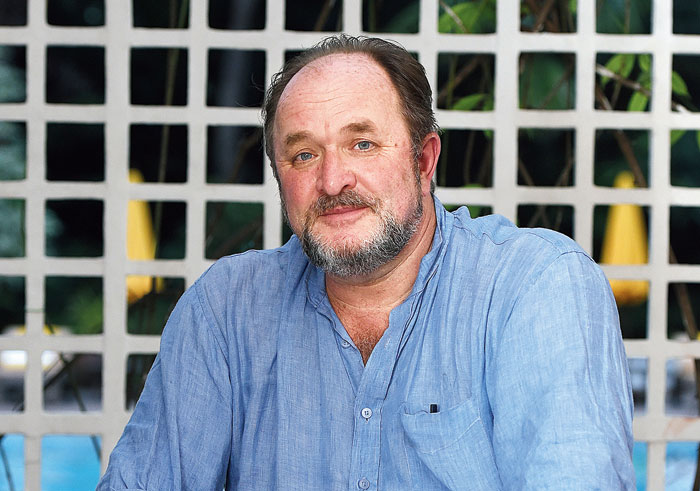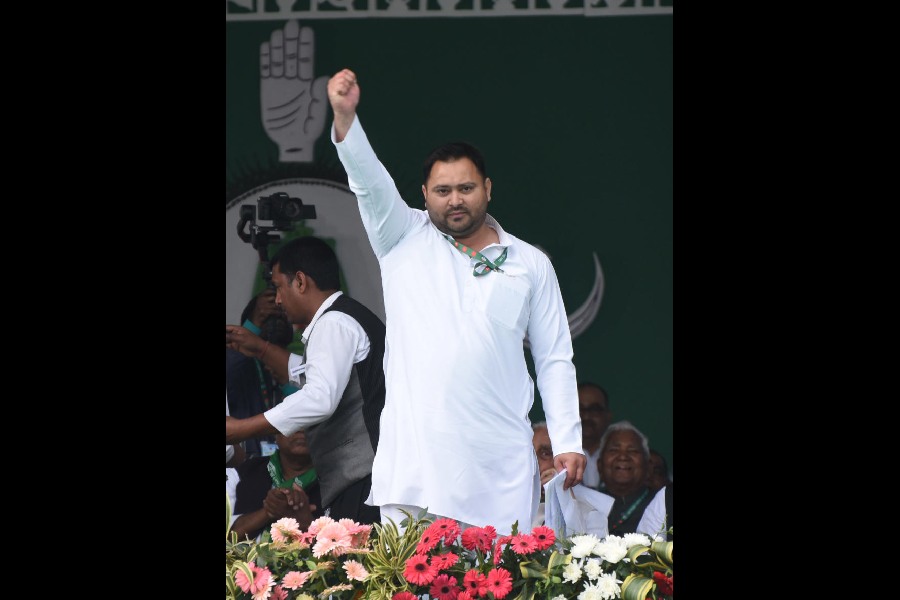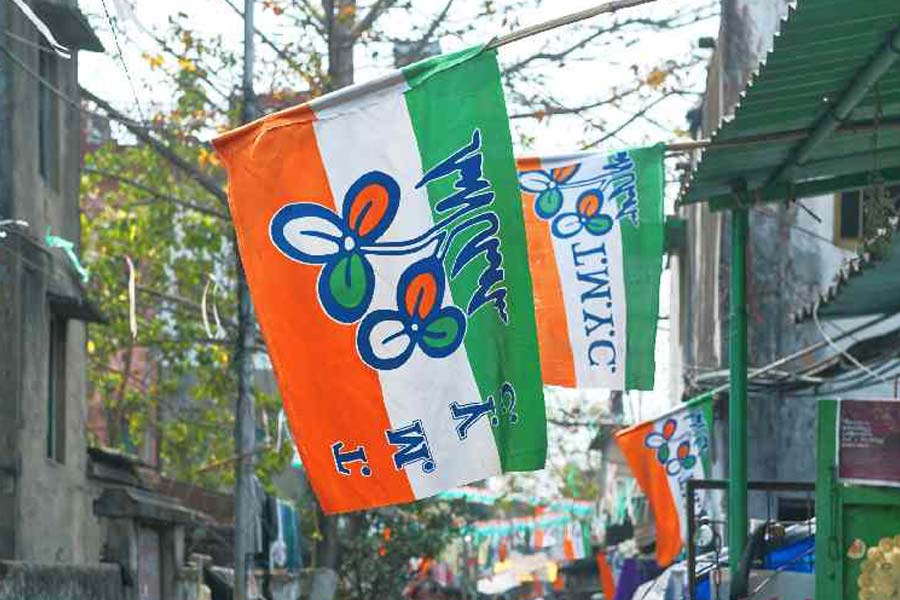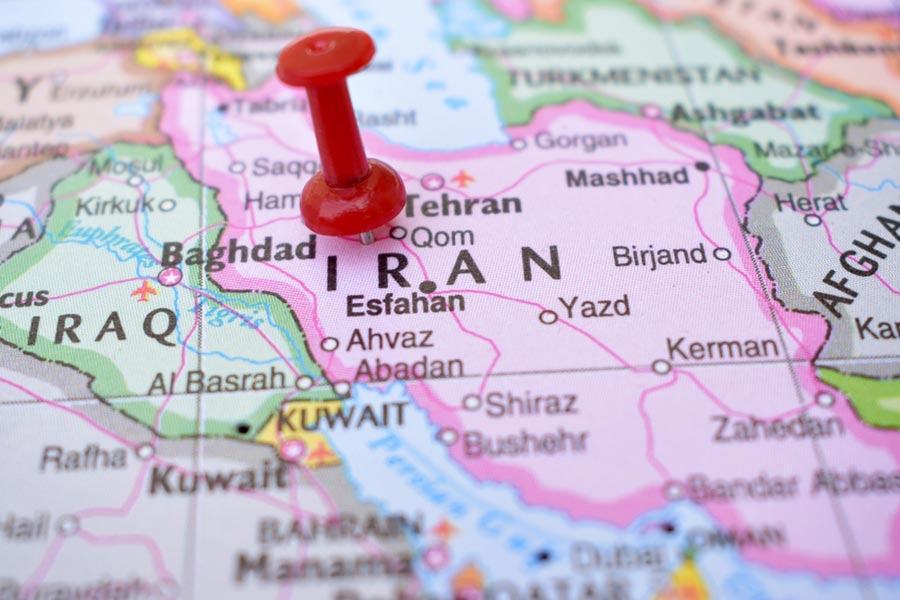As I wait for William Dalrymple by the poolside of the elegant Taj Bengal to talk about The Anarchy: The East India Company, Corporate Violence, and the Pillage of an Empire, I rummage through memories of our past associations that started with Jaipur Lit Fest in 2007, continued through India Market Focus at London Book Fair in 2009 and the launch of Nine Lives: In Search of the Sacred in Modern India, the most unusual book in his oeuvre of compelling histories and travelogues. William arrives a touch late, understandably a tad tired, the result of the punishing book tour he has taken on, his presence larger than the sum of the many parts of his persona, just as I remembered him, in a blue linen shirt, cream chinos and trekking boots. The beard is new though, in keeping with the times. He sheepishly declares that the fish he ate the previous night didn’t quite agree with him, and then adds with his characteristic guffaw, “I should have waited to arrive in Calcutta for the fish.”
I ease into the adda with the writer, photographer, lit fest director and a great raconteur by pointing out that it’s just after Durga Puja, in some ways the perfect setting for our conversation on the East India Company’s opportunistic beginnings and rise and rise to hubristic heights. William is transported back to his trip to the city in 2016 during Durga Puja, when he produced a series of startling pictures of the festival while rootling around for his ancestors in old mansions and cemeteries. The umbilical links go back to three generations, beginning with Stair Dalrymple who perished in the purported “Black Hole” incident after Siraj-Ud-Daulah, “a degenerate despot and a bisexual rapist, by the contemporary accounts, a bit like Uday Hussein, Saddam’s notoriously cruel eldest son”, he says. “We know he died and therefore the incident did happen, but the extent of the tragedy was perhaps exaggerated,” Dalrymple adds.
He expands on the Bengal connection of The Anarchy: “the book is overwhelmingly about Bengal, and even when the scene shifts to other parts of India, it still is about the resources of Bengal powering the rise of a ruthless, weaselling corporation.” However, he pauses to add emphatically that the book is also about the improbable rise of this corporation and not Britain. “East India Company (EIC) is not Britain in as much as Facebook is not American.” The parallels he draws with the here and now are compelling all through our conversation. “At the beginning of the 18th Century, the Mughal empire was producing 37 per cent of the world’s GDP, and had just overtaken China, whereas Britain accounted for less than 3 per cent. The EIC’s takeover of the Mughal empire was as improbable as a single company from Burkina Faso now taking over the US,” he points out by way of comparison.
Parallels like these across time and geographies make for compelling reading. In 1799, for example, as Britain was arming up to face the Napoleonic threat on the continent with a force of 100,000 troops, EIC’s army in India was exactly double that, at 200,000. “I have worked quite hard to work that out,” Dalrymple lets slide. The sixth chapter, which has some harrowing details of the Great Bengal Famine of 1770, concludes around 1780 with a deft comparison between the dip in fortune of the EIC in India as well as alarm bells ringing for the King’s men in America.
“The book is about the audacity of a corporation and explores the wider question of the conflict between a very powerful for-profit company and the state. In this particular story, the state wins by nationalising the corporation and then it becomes the Raj.” But will all stories end like that? “It remains an unanswered question as powerful corporates the world over either battle or collude with governments for their own profit.”
It is difficult not to be struck by the cyclicality of history in the opening chapter where Dalrymple’s narrative taps into the anxieties in Britain about the French and the Dutch empires leading to the formation of the EIC in 1599, and I point out that the more recent concerns in the island nation that has fuelled Brexit are not dissimilar emotions. Dalrymple concurs, but says, “It is very odd, because when I started researching the book in 2013, none of these ideas or words were around. And the reception of the book has been interesting. In the US it has been read as a cautionary tale about Big Tech and Elon Musk’s ambition to colonise Mars, and in Britain there has been a bit of surprise about what people’s forefathers were up to — ‘was it really that bad?’ I have been asked.”
A staff from the restaurant comes around to take our orders and almost instinctively I ask for a cup of Darjeeling tea. Dalrymple laughs at this ironic choice — a drink that played a prominent role in the anarchy that was the EIC has traipsed almost unannounced into our adda. He settles for a cappuccino.

The Last mughal Book cover
The Anarchy is a page-turner. Dalrymple’s style challenges the more dry ways of historiography that relies on research and then sequencing of events chronologically. Consider, for example, the beginning of Chapter two: “In early November 1755, an anonymous figure trained a telescope across the wintry estuary of the Scroff and beyond…” — but more importantly pauses, with some deliberation and heightened drama, on the interstices of key events that shape our history and instigates counterfactual questions. As was the case with Shah Alam (“the real hero of the book, and Clive is the villain,” Dalrymple simplifies in classic Bollywood terms) who could have seized Murshidabad, and with it Bengal, had he not diverted to Burdwan and tarried for three days there, early in his campaign to seize the Diwani back from the Company in February 1760. The re-telling of the fluctuating fortunes of Shah Shuja and Major Hector Munro in the Battle of Buxar is riveting. Dalrymple similarly slows down the flow of events around the Battle of Pollilur and allows readers the time and opportunity to ask the pertinent question: what if the young Tipu had pursued General Eyre Coote’s exhausted forces?
The book has a sharp focus on the events that shape the Company’s fortunes between 1756 and 1803 and the tragic figure of Shah Alam (“handsome, sophisticated, urbane and gallant”, in the words of Dalrymple) dominates the story. The interesting subplot surrounds that of Robert Clive and Warren Hastings, the former a ruthless, avaricious opportunist, fiendishly clever and physically brave soldier who hated India and its inhabitants (“Clive was a village thug, straight out of Gangs of Wasseypur”, Dalrymple helpfully adds), and the latter an austere polyglot, an Indophile who helped found the Asiatic Society, as scrupulous as he was diligent, and as the infamous duelling incident with Philip Francis on the grounds of Belvedere House (now the National Library) proved, not much of a soldier. “Traditional history scarcely cares for the humanity of these characters,” says Dalrymple, “and it is only when you get to their letters do you get to know them in person.” He then adds, “Hastings is someone one would like to have a drink with.” And after a moment’s pause, adds impishly, “He wasn’t much of a drinker though, had just a glass of wine every evening. What a pity.”
Though he started off his writing career as a travel writer, with the sparkling In Xanadu (he dismisses it as “a callow work, and perhaps borderline racist”), he has hovered around the 18th Century in the subcontinent in eight of his 14 books, not counting The Anarchy. Why is he so obsessed with that period? “It’s so richly recorded through the sheer variety of source materials — from Persian, Urdu, Hindustani, English but also French and Dutch and Portuguese. The economic history of the period is well documented. I enormously admire the work of Rajat Kanta Ray, Kumkum Chatterjee, Lakshmi Subramanian, Rajat Datta. But there is a dearth of political histories of the period focusing on the characters themselves. A lot of the Persian sources have not been translated.I find the French traveller (Comte de) Modave’s accounts particularly illuminating, and Modave was Voltaire’s friend and neighbour.” Dalrymple admits to reading only a little bit of Persian but relying chiefly on the translations of Bruce Wannell, with whom he has a very close working relationship. “Much of the best ornaments of this book are down to Bruce’s superb translations,” acknowledges Dalrymple generously. He gushes about using the biography of Shah Alam by Munshi Munna Lall in a library in Tonk, Rajasthan, which had eluded even Jadunath Sarkar.
Just a few days back Amit Shah had made a plea for the need to write India’s history from India’s perspective. What does he make of that, and the occasional snide remark of him not being an Indian historian? Dalrymple is in no mood to rake up a controversy and readily concedes that there is a point to be made there. But at the same time he feels that with the exception of Ramachandra Guha, no one is really writing credible histories that are also accessible and can win literary prizes. He gives the example of “Harvard historians” like Sven Beckert and Stephen Greenblatt, (and gently slides in that Greenblatt will be in Jaipur Lit Fest in 2020). He feels he has been very lucky that way to find success, and welcomes the rise of Manu Pillai, Parvati Sharma, Ruby Lal et al. He is passionate about making history readable, but has no issues with “dense economic histories that mine enormous data.”
Dalrymple is dismayed at the general lack of historical awareness and reading in India, often replaced by a more mythological understanding of history that leads to enormous social media battles. “What has raised a few eyebrows with this book is the awareness that the Mughals didn’t just build grand monuments, but were great at industry and commerce, and just as that empire was about to disintegrate, India surpassed China in economic worth for the first and only time in recorded history.”
The Cambridge historian Steven Runciman is his great hero and model for writing, and Dalrymple’s style of putting the references as endnotes, after all the chapters, rather than footnotes under each page, he acknowledges, comes from Runciman. For example, the arguments around the degree of responsibility that EIC bore for the Bengal Famine of 1770 is dealt with in endnotes that run into three pages. But they do not interrupt the flow of the narration in the chapter per se. There are over 100 pages of notes in this 522 page book. “And the notes keep getting longer with each book,” laughs Dalrymple. The humour that leavens our conversation is also sprinkled liberally in the book. When the news of Siraj-ud-Daulah’s death reaches London, “an inattentive Company director asks another, was it true that the recently assassinated Sir Roget Daulat was a baronet?”

Pictures: B. Halder
The Anarchy took six years to write. And it was a fairly complex process that Dalrymple has perfected over the years. He starts reading up the primary and secondary sources about his next project as soon as he finishes one book. With The Anarchy, he spent a year reading primary sources in India and in the UK. Then a retinue of research scholars — mostly postgrad students from JNU — worked with him to compile and copy the relevant materials from the National Archives in Delhi and his sister-in-law did the same in the British Library in London. Then began the most complex and long-drawn process of translations from Persian, Urdu and Hindustani which were done by Bruce Wannell and took about two-and-a-half years. The actual writing took about nine months “it is quite quick really, a flash fry after all the ingredients have been sliced, diced, chopped and marinaded” is how he puts it.
He doesn’t quite go down the Graham Greene path of a precise and exacting routine (the English novelist would write exactly 500 words each day, which he counted on his fingers, and just stopped, even if he was mid-sentence) but makes it a point to take out a printout of each day’s work even if that is the last thing he does before going to bed. In the morning, he doesn’t touch his phone and the first thing he does is correct and edit the previous day’s work. A heavy breakfast later, he dives into the writing, which goes on till about 4 pm. “After which, I collapse in a heap in front of Netflix and snore.”
Next up for Dalrymple is actually an extension of this book. It’s a catalogue for an exhibition of paintings commissioned by the Company that will open in London on December 3 at the Wallace Collection. “While writing this book was a darker, negative experience because of the nature of materials I was handling, the catalogue is much happier, lighter work. It is incidentally, again, a Calcutta book because many of the paintings are about life in Calcutta.”
I have overshot the time allotted for the chat, and I gather from peripheral conversations that Malavika Banerjee of Tata Steel Kolkata Literary Meet is waiting for him in the hotel lobby. But I remember just in time a few questions team t2 wanted me to put to Dalrymple. How does an author separate the personal from the professional while researching a book like this? “With the 18th Century, one comes at it from a distance, of course, and it is not like Congress vs BJP. But it can occasionally get to you. For example, I don’t take kindly to suggestions that the Black Hole incident didn’t happen at all. But one also approaches the subject matter with an open mind. I hadn’t anticipated the depravity of Siraj-ud-Daula for instance till I read accounts of him by his cousin. He turns out to be a spoilt little punk, not quite the tragic hero of Plassey. He met his match in Clive in ruthlessness and low cunning.”
And how does he capture the supposedly short attention span of the millennials with his very minutely researched tomes? Meenakshi Singh from Bloomsbury India points out that The Anarchy has already sold over 45,000 copies in India and similar numbers in the UK. Later in the week I pick up a tweet that it has sold over 100,000 copies worldwide. “You need to convince people that the book is worth tackling; that the content is relevant and exciting as is the telling of the story. That is what the success of Harry Potter showed,” says Dalrymple. And that I think is the essence of Dalrymple, the writer: he is perpetually digging for the story in history.
Debanjan Chakrabarti is director of British Council in East and Northeast India. In a previous role as head of Intercultural Dialogue Programme in India and Sri Lanka between 2007 and 2010, he had worked with William Dalrymple for Jaipur Lit Fest and India Market Focus at London Book Fair










